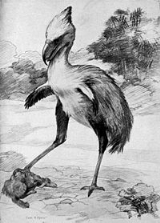
Phorusrhacos
Overview
Genus
In biology, a genus is a low-level taxonomic rank used in the biological classification of living and fossil organisms, which is an example of definition by genus and differentia...
of giant flightless predatory bird
Bird
Birds are feathered, winged, bipedal, endothermic , egg-laying, vertebrate animals. Around 10,000 living species and 188 families makes them the most speciose class of tetrapod vertebrates. They inhabit ecosystems across the globe, from the Arctic to the Antarctic. Extant birds range in size from...
s that lived in Patagonia
Patagonia
Patagonia is a region located in Argentina and Chile, integrating the southernmost section of the Andes mountains to the southwest towards the Pacific ocean and from the east of the cordillera to the valleys it follows south through Colorado River towards Carmen de Patagones in the Atlantic Ocean...
, containing the single species
Species
In biology, a species is one of the basic units of biological classification and a taxonomic rank. A species is often defined as a group of organisms capable of interbreeding and producing fertile offspring. While in many cases this definition is adequate, more precise or differing measures are...
Phorusrhacos longissimus. Their closest living relatives are the much smaller seriema
Seriema
The seriemas are the sole extant members of the small and ancient family Cariamidae, which is also the sole surviving family of the Cariamae. Once believed to be related to cranes, they have been placed by one recent study near the falcons, parrots and passerines, as well as the extinct terror birds...
birds. The terror birds lived in woodland
Woodland
Ecologically, a woodland is a low-density forest forming open habitats with plenty of sunlight and limited shade. Woodlands may support an understory of shrubs and herbaceous plants including grasses. Woodland may form a transition to shrubland under drier conditions or during early stages of...
s and grasslands.
Among the bones found in the stratum of the Santa Cruz Formation (now considered as mainly of mid-Miocene
Miocene
The Miocene is a geological epoch of the Neogene Period and extends from about . The Miocene was named by Sir Charles Lyell. Its name comes from the Greek words and and means "less recent" because it has 18% fewer modern sea invertebrates than the Pliocene. The Miocene follows the Oligocene...
date) was the piece of a mandible which Florentino Ameghino
Florentino Ameghino
Florentino Ameghino was an Argentine naturalist, paleontologist, anthropologist and zoologist.Born in Luján, son of Italian immigrants, Ameghino was a self-taught naturalist, and focused his study on the lands of the southern Pampas...
(1887) at first described as that of an edentate mammal
Mammal
Mammals are members of a class of air-breathing vertebrate animals characterised by the possession of endothermy, hair, three middle ear bones, and mammary glands functional in mothers with young...
.
Unanswered Questions

